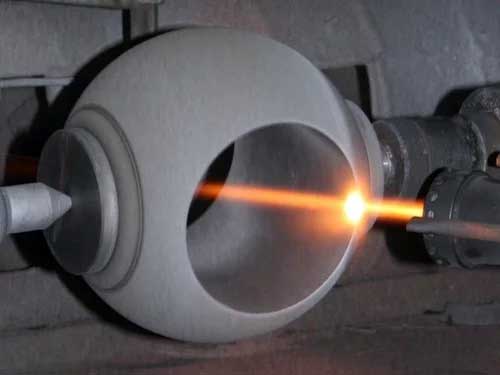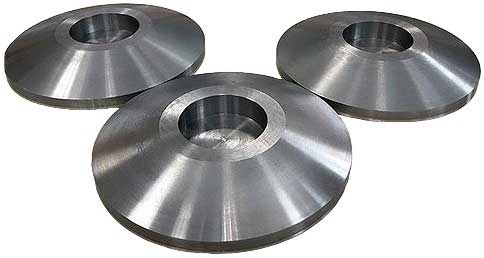Hard-facing valve parts
Hardfacing is a metalworking process in which harder material is applied to delicate surfaces to reduce such damage.
Entire parts can be made of the hard material, but that is usually a much more expensive solution. Internal parts of many different types of valves can benefit from hardfacing, such as gate valves, check valves and butterfly valves.
Metal alloys for hardfacing can be applied using a variety of processes, including..
- Laser
- Welding
- Flame spraying
- Plasma spraying
- High-speed oxygen spraying
To ensure the quality of a hardfacing application, test for hardness, corrosion, thickness, adhesion and other characteristics of the overlay and perform a metallographic examination of the base material.
Hardfacing Materials
The most commonly used material for hardfacing valve inserts is Stellite 6, a cobalt alloy containing chromium, tungsten, carbon and other elements. The table below gives the chemical composition and some physical properties of the Stellite 6 alloy. A hard carbide phase in the matrix of the CoCr alloy makes this material highly resistant to corrosion and galling.
| Co | Cr % |
W % |
C % |
Others | Hard | Density | Melting range |
| Base | 27 - 32 |
4 - 6 |
0.9 - 1.4 |
Ni, Fe, Si, Mn, Mo | 36-45 HRC 380-490 HV |
8.44 g/cm3 0.305 lb/in3 |
2340-2570°F 1285-1410°C |
22Cr duplex stainless steel is widely used for piping systems, including valves, in the offshore industry. However, applying Stellite 6 to 22Cr duplex is challenging because of the formation of a sigma phase in 22Cr duplex during welding, which can lead to embrittlement.
Chromium and molybdenum generally increase the precipitation rate of the sigma phase. The risk of sigma phase precipitation is higher for smaller and thinner duplex parts with Stellite 6 overlay because of the higher heat concentration during weld overlay. Instead of using Stellite 6 overlay on smaller 22Cr duplex parts (e.g., 4 in. and less), an alternative is to make the parts from solid Stellite 6 to avoid the problems associated with overlay welding.
Seawater applications are not suitable for Stellite 6 because of the risk of cracking in that environment. Ultimet hardfacematerials are better suited for valves used in seawater.
Cobalt alloy, Ultimet (UNS R31233), offers excellent wear resistance properties. Ultimet contains chromium, nickel, molybdenum, iron and tungsten. Valve manufacturers found Ultimet slightly more difficult to overlay than Stellite 6. Achieving sufficient adhesion of Ultimet to the base material can be challenging in some cases, leading to loss of the overlap layer after several years of use. The offshore industry often uses Ultimet overlay on components of 25Cr duplex valves used in seawater.
Hardfacing with nickel- or cobalt-based Tribaloy alloys can protect parts exposed to extreme wear, high temperatures or corrosive materials. The Tribaloy 800 alloy contains a large amount of molybdenum, which increases its resistance to pitting corrosion in seawater. This cobalt-chromium-molybdenum alloy also has high resistance to erosion, corrosion and galling.
Tungsten carbide, a combination of tungsten and carbon, tolerates high temperatures and offers extreme wear resistance.
 Tungsten Carbide Coated Ball of a Ball Valve
Tungsten Carbide Coated Ball of a Ball Valve
Tungsten carbide coatings are often applied by a thermal spraying process using high velocity oxygen fuel (HVOF). In this process, the coating particles are hurled at extremely high speed toward the substrate surface and melt to the surface by their kinetic energy rather than by increased temperature. Tungsten carbide coating thickness is usually limited to 150 microns or less because of porosity problems with thicker coatings.
Stellite 6 hardfacing by laser overlay
Laser cladding offers many advantages over traditional welded overlay, including less heat input, a smaller heat-affected zone, less thermal deformation, better adhesion, more uniform overlay layers and less iron from the substrate diluting the Stellite.
 Stellite 6 Cobalt Based Alloys Casting Parts
Stellite 6 Cobalt Based Alloys Casting Parts
SOME FACTS
Erosion is weight loss of material caused by process flow, especially if the fluid contains particles. Corrosion can accelerate erosion, and even a material that is completely resistant to erosion and corrosion can fail due to friction.
Galling is a form of wear caused by adhesion between two sliding surfaces and usually occurs when components of similar hardness slide over each other in a dry or non-lubricating fluid condition.
Cavitation occurs when the pressure in a fluid suddenly drops and vapor bubbles form in the fluid. When the bubbles collapse, pressure waves are created that can damage the internal components of the valve. Cavitation can cause irregular pitting and erosion in the valve, as well as noise and vibration.
Conclusion
Internal parts of valves, such as seats and closures, can be at high risk for erosion, wear, corrosion, galling and cavitation damage. Hardfacing - applying harder material to vulnerable parts - can mitigate such damage. A hardfacing material, such as Stellite, Ultimet, Tribaloy or tungsten carbide, can be applied by welding, spraying, HVOF or laser.
Different hardfacematerials are suitable for different operating conditions, and the process used to apply hard materials must be compatible with both the material and the substrate. Both the hardfacematerial and the application method must be carefully chosen.